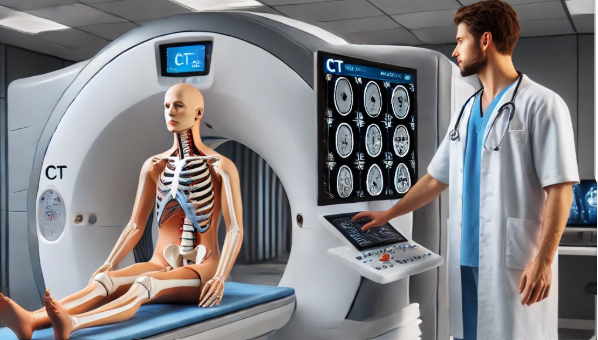In the world of modern healthcare, Radiation-Free CT Simulators CT scanning plays a vital role in diagnosing a wide range of conditions. As the demand for accurate imaging grows, so does the need for skilled radiographers. However, training students on real CT simulators can come with risks—mainly due to repeated radiation simulation exposure.
This is precisely where radiation-free CT simulators, powered by AI simulation, are making a significant difference. As a result, these next-generation tools offer a realistic, safe, and cost-effective way to teach CT procedures. Moreover, they eliminate the risk of radiation exposure for students, making them an ideal solution for modern medical training.
Why We Need Radiation-Free CT Simulators?

Learning to operate a CT scanner isn’t just about pressing buttons. It involves understanding CT imaging, patient positioning, scan parameters, and interpreting results—all while ensuring patient safety. Traditionally, radiographer students train on actual machines. But repeated CT simulation radiation exposure isn’t ideal, especially for beginners.
With a radiation-free CT simulator, students can practice in a fully controlled, repeatable, and safe virtual environment. These simulators recreate real-life CT simulation scenarios without any health risks. This not only improves safety but also builds student confidence before they move on to real patients.
How Does Radiation-Free CT Simulators Work?
A radiation-free CT simulator is designed to mirror the experience of operating an actual CT scanner. It uses realistic controls, digital mannequins, and AI-powered software to deliver hands-on training. Through simulation experiments, students can learn:
- Patient positioning
- Scan protocol selection
- Dose and image quality balancing
- Anatomy identification
- Handling emergency scenarios
These tools fall under the broader field of simulation healthcare, which is changing how future professionals are trained across medicine, nursing, and radiology.
OneSimulation: Leading the Change in Globally

One of the leading names in this revolution is OneSimulation. Based in India, this innovative company offers next-gen AI-based radiation-free CT simulators designed especially for medical colleges and training institutes.
What makes Radiation-Free CT Simulators stand out?
- Radiology simulator with lifelike CT scanning interface
- Integrated mannequins for patient positioning practice
- Pre-loaded case studies for multiple learning scenarios
- Full-body anatomical datasets for detailed CT imaging practice
- No radiation, making it completely safe for repeated use
This technology is ideal for medical colleges, radiology departments, and private training institutes looking to modernize their radiographer training programs.
Why Radiation-Free CT Simulators Important for Globally?
The role of radiation-free CT simulators in Globally is especially important due to the growing healthcare workforce and increasing demand for diagnostic services. Many training centers lack the infrastructure to provide frequent, hands-on access to real scanners. And when they do, safety becomes a concern.
With AI simulation and virtual training models like OneSimulation’s, institutes can now offer consistent, safe, and effective training without needing physical machines or risking exposure. This levels the playing field for students across urban and rural globally, helping to bridge gaps in medical education.
The Future of CT Education for Radiographers
The future of CT education in radiographer training lies in innovation. Students no longer need to wait for live patient cases or worry about radiation safety. They can now run CT simulation sessions anytime, anywhere, at their own pace.
These simulators also make it easier for educators to assess student performance, provide feedback, and track progress. It’s a complete shift from traditional training methods—one that saves time, costs less, and improves learning outcomes.

Moreover, these healthcare tools prepare students better for the real world. By the time they start working in hospitals or diagnostic centres, they already know how to operate machines, interpret scans, and manage patient care.
Conclusion
As healthcare continues to evolve, so must the way we train future professionals. The radiation-free CT simulator is not just a technological upgrade—it’s a safer, smarter, and more accessible way to teach radiography. With companies like OneSimulation leading the way, globally is well on its path to modern, high-quality radiographer education.
The combination of CT simulation, AI simulation, and safe, repeatable learning is the perfect formula for preparing the next generation of radiology experts—without the risks of radiation. The future of CT healthcare training is here, and it’s safer than ever before.

